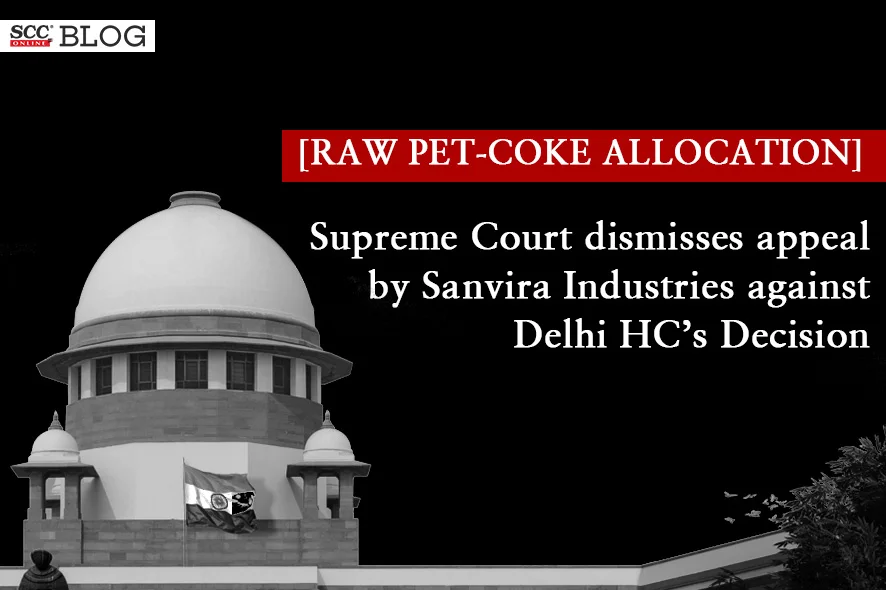Supreme Court: In a batch of civil appeals, the appellants were challenging the decision of the Delhi High Court, wherein the decision of the Central Government allocating the pet-coke was set aside and the allocation of quantities of Raw Pet-Coke (‘RPC’), a residue of the leftover from the refining of petroleum products and sand crude as well as other heavy oils was in issue in the present appeals, the Division Bench of S. Ravindra Bhat* and Dipankar Datta, JJ., dismissed the appeals and upheld the impugned decision of the division Bench of the High Court.
Background
The Director General of Foreign Trade (DGFT) had determined the criteria for the allocation of imported RPC and its allocation among various entities. The Central Ministry of Environment, Forest and Climate Change (‘MoEF’), officers of the Environment Pollution (Prevention and Control) Authority for NCR and the Ministry of Petroleum and Natural Gas (‘MPNG’) had decided in principle that import of pet-coke ought to be restricted only to industries using it as a feedstock or as part of their manufacturing process and not as fuel. The Sanvira Industries/ appellants (‘Sanvira’) wrote on 12-09-2018 to the Environment Pollution Control Authority (‘EPCA’) intimating its production capacity of calciners and indicated that its capacity was 2,00,000 MT. The EPCA on 06-10-2018 filed a report before the Court regarding the import of RPC for aluminium, calciner, and steel industries in the context of restrictions imposed on the import of RPC. The EPCA recommended that the total import requirement of RPC was 1.4 million tonnes per annum (‘MTPA’) and Sanvira’s capacity was taken as 2,00,000 MTPA.
Later, the Court had directed that RPC import cannot exceed 1.4 MMTPA and that it could be used as feedstock for producing CPC. On 26-11-2018, a public notice was issued by the Ministry of Commerce and Industries (‘Ministry’), stipulating the way in which DGFT would allocate the quota of RPC to eligible CPC manufacturing units within the given ceiling limit. On 27-12-2018, the DGFT, in furtherance of the first public notice initiated the process for allocating RPC. Its allocation became the subject matter of controversy by Sanvira as well as Rain CII Carbon (Vizag) Ltd. (‘the respondent’). Sanvira had contended that its production capacity was 330,000 MTPA which was not taken into account while providing allocation. The Sanvira and others including the present respondent had filed an application, and all the applications were rejected by the Court.
Subsequently, Sanvira’s allocation was increased pursuant to the Andhra Pradesh State Pollution Control Board’s (‘APPCB’) inspection of their unit. The respondent had challenged the said increased allocation in a petition, however, the said petition was set aside by the Single Judge Bench. The Division Bench of the High Court held that Sanvira’s increased capacity (of 1,30,000 MT) was granted only on the basis of an agenda item placed before the APPCB and that though Sanvira could produce 3,30,000 MTS, that did not automatically lead to the inference that they were entitled to an increase in their share of the total import permissible by the orders of the Court. Thus, forming the impugned Judgment in the present appeal.
Court’s Decision
The Court noted that the Court had fixed the outer limit of import of RPC at 1.4 MTPA, based on the assessment by EPCA which evaluated the requirements of various industries and units, engaged in the production of diverse commodities and raw materials (such as steel, aluminium, cement, clinker and those of calciners). The Court said that it was clear that the Consent to Operate Certificate(‘CTO’) mentioned the Sanvira’s capacity at 2,00,000 TPA and Sanvira’s position was that the CTO for an additional 1,30,000 TPA was granted on 29-11-2018 and that the application for such capacity was made on 29-10-2018. It was also said that it was a matter of record that the APPCB issued the CTO for the quantity of 3,30,000 TPA only for 23-12-2019. The Court also noted that it was clear from the Order of the Union Ministry dated 13-02-2020, that any capacity added by the procedures after the Order of the Court dated 09-10-2018 would not be taken into consideration while allocating the RPC. It was also recorded in the minutes of the meeting that Sanvira’s additional capacity was created after the Court’s 09-10-2018 order.
The Court said that the Division Bench had correctly noted that the annual total limit of import of 1.4 MTPA was based on the total production capacity as on 09-10-2018 which had been fixed by the Court on the basis of the capacity disclosed by all the calciners. The Court said that the Division Bench had also observed that an SPCB could indicate the permissible limit of production of calcined petroleum coke, for Sanvira it was 2,00,000 MTPA; the consent to produce 3,30,000 MTPA of coke was given only after 29-11-2018. Therefore, the Court said that the same position could not have been considered by the Court. Further, the Court said that the certificate dated 04-05-2020, issued by the APPCB merely certified that the installed capacity of Sanvira, as on 09-10-2018, for manufacturing calcined petroleum coke, was 3,30,000 MTPA in terms of the CTO.
Thus, the Court viewed that the impugned decision of the Division Bench was correct and there were no infirmities in the said decision. Therefore, the Court dismissed the appeals.
[Sanvira Industried v. Rain CII Carbon (Vizag) Ltd., 2023 SCC OnLine SC 754, Decided on 03-07-2023]
*Judgment Authored by: Justice S. Ravindra Bhat






